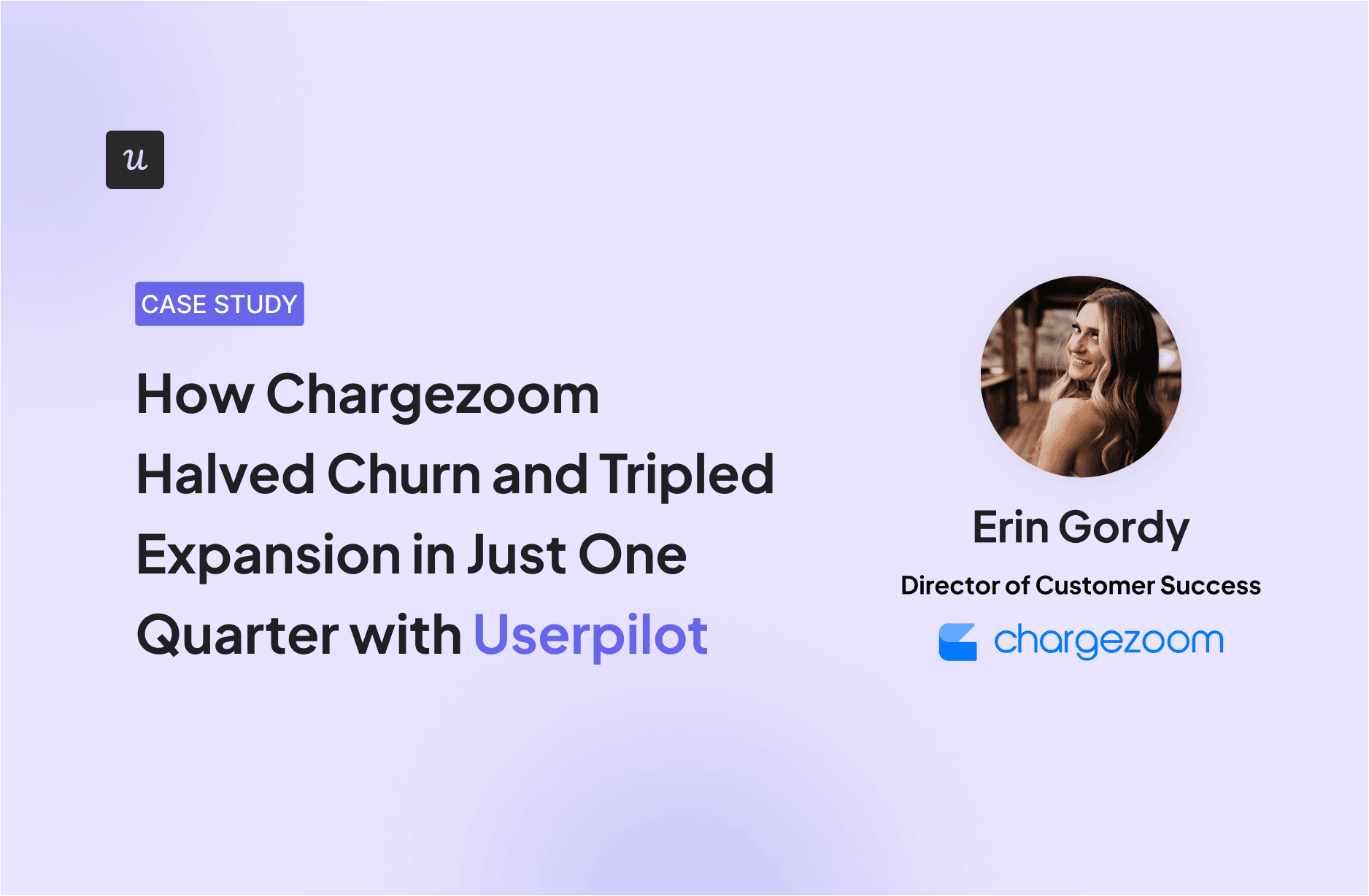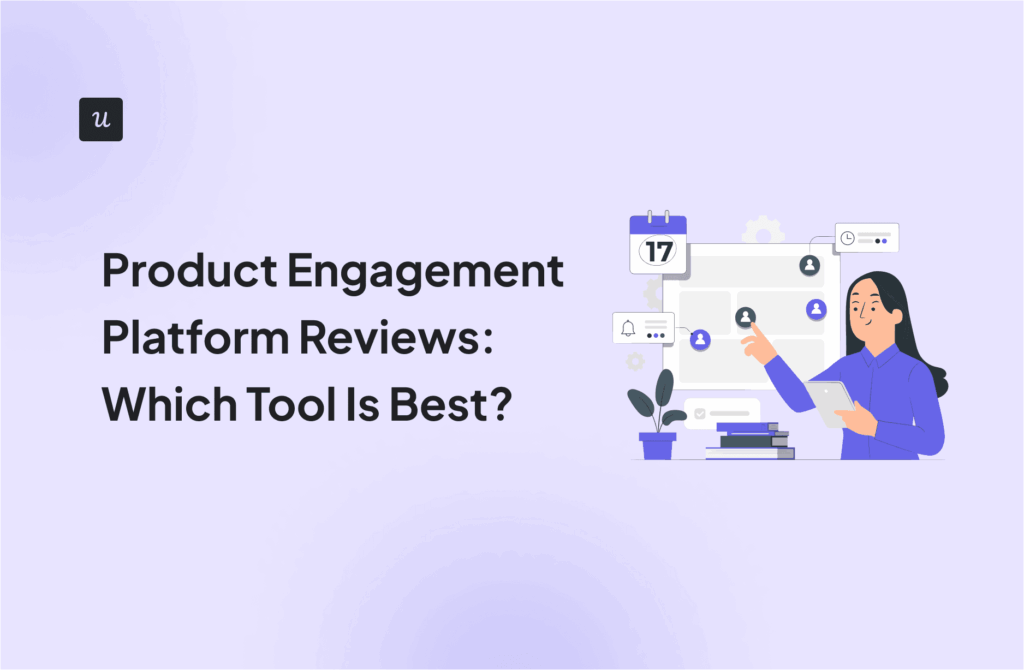
How Chargezoom Halved Churn and Tripled Expansion in Just One Quarter with Userpilot
Chargezoom, a B2B invoicing platform, struggled to keep up with its ever-increasing customer base.
The business was growing, but the success team was getting overwhelmed because they were 4 people trying to support 2,500+ customers.
To solve this, Chargezoom’s team leveraged Userpilot’s in-app engagement features to not only increase the efficiency of their process but to reduce churn by half while still growing the customer base.
So, for this article, we asked Erin Gordy, the director of customer success, to tell us how her team went from being on the verge of collapsing to preventing churn and increasing account expansion.
Try Userpilot Now
See Why 1,000+ Teams Choose Userpilot

Challenge: 2,500+ customers vs. 4 CSMs
Chargezoom was scaling quickly, but with only 4 people in the team trying to reduce churn, they couldn’t support users proactively, promote new features, or analyze user interactions within the product.
As Erin Gordy explained:
“We just didn’t have any insight into what our customers were doing. People were dropping off, and we didn’t know why. We wanted to start tracking activity to figure out the warning signs of users who are dropping off or the green flags of a customer who is using the product in a good way.”
– Erin Gordy, Director of Customer Success at Chargezoom
Solving this problem required facing these four critical issues:
- The team was limited. With only two team members available to run onboarding sessions and send emails, the team couldn’t keep up. Many new users would skip the sessions and use the product themselves, meaning they’d be unable to experience the full value of the product.
- Email-only communication. Messages about new features or value-adding upgrades would get lost in inboxes. As a result, many users continued using Chargezoom for just one or two core tasks, while being unaware of the time-saving features they were already paying for.
- Cancellations were unnoticed. Without the capacity to track customers at scale, churn was often discovered long after it happened.
“I was literally asking my product team to pull a report every other week of who upgraded or downgraded. Then I’d go and manually reach out to them. It was reactive instead of proactive outreach.”
– Erin Gordy, Director of Customer Success at Chargezoom
- Expansion growth was stalled, and churn hovered around 4%. With no visibility into user behavior, the team would consistently miss churn signs and upsell opportunities.
Solution
Chargezoom’s team was already implementing ChurnZero to deal with their churn problems.
However, although ChurnZero shares many features with Userpilot, they decided to stay with Userpilot because ChurnZero’s outputs weren’t as smooth. Or as Erin said:
“ChurnZero can automate in-app messages, but they look really clunky. Whereas Userpilot has a way of making in-app messages look like they were actually built within the app. Our product needs to look as good as big companies like Salesforce and Hubspot, and Userpilot achieves that “native” feel.” – Erin Gordy, Director of Customer Success at Chargezoom
Now, besides in-app messaging, Userpilot also helped the CS team scale proactive engagement, increase expansion, and streamline processes while staying lean. Here’s how:
1. Adding self-service support to reduce user queries
A CS team of four vs. 2,500+ customers would be a losing battle without scaling support or automation.
To work around this, the CS team used Userpilot to build an in-app resource center that includes several help options, including:
- FAQs.
- In-app walkthroughs (especially helpful if you tend to dismiss them).
- Knowledge base.
- The ability to book a support call without having to send an email.
- A form to submit suggestions or complaints (great for collecting passive feedback).

This way, Chargezoom users can get the support they need without leaving the product. Also, the team can focus more of their time on strategic work and solve more critical issues.
“This help portal is at the discretion of of the user. So if they don’t wanna be walked through (for example) the subscription feature, they don’t have to be. But if they do want to or if we update the feature, there will be a guide that goes all the way through the steps—instead of them having to email us to get on a call so that we can walk them through it.”
– Erin Gordy, Director of Customer Success at Chargezoom
2. Implementing in-app onboarding checklists and tooltips
As mentioned earlier, Chargezoom relies on four people to conduct 45-minute onboarding calls to get new customers up to speed.
So, besides building an in-app resource center, Chargezoom’s team also leveraged Userpilot to build onboarding checklists that walk users through the basic tasks right inside the product. It serves as an additional support for users, especially those who didn’t show up or decided to skip onboarding sessions.

“Most customers only used our product for one thing. They didn’t even realize all the other features that could make their lives easier until we started guiding them with Userpilot.”
– Erin Gordy, Director of Customer Success at Chargezoom
On top of that, the team also added tooltips and step-by-step flows to nudge users toward features they would have otherwise missed. For example, there’s a tooltip that introduces the batch invoicing feature and indicates the checkbox to activate it.

“Tooltips have been great because they give a bite-sized dose of knowledge that you need right. Now users not only can see the value in higher features, but also experience the value in the software itself. They’re sticking with us for longer.”
– Erin Gordy, Director of Customer Success at Chargezoom
This move from reactive onboarding to proactive support significantly reduced the workload on users, helped them realize the value of secondary features, and mitigated the number of live chat queries.
3. Introducing new features in-app to encourage adoption
Email had been Chargezoom’s primary way of communicating with users.
But with Userpilot, Chargezoom can send in-app messages to communicate product updates, feature launches, and process changes. As well as trigger them at the exact moment and place a user needs to know about them.
“Emails took forever and things slipped through the cracks. We would sometimes go months without realizing someone canceled because it was impossible to keep up manually. Now users get immediate help through in-app experiences without waiting for a support response.”
– Erin Gordy, Director of Customer Success at Chargezoom
This approach was able to put new features in front of users, encouraging them to upgrade their plan and stick with the product. All of this, without having to reach out manually through email, respond to support tickets, or schedule 1-on-1 calls.
4. Tracking in-app interactions and refining future strategies
One of Chargezoom’s biggest challenges was the lack of visibility into user behavior. As we mentioned, the team had no easy way to understand how customers were engaging with the product or to spot early signs of churn.
With Userpilot, the team can monitor user interactions with tooltips, flow completions, and clicks on upgrade prompts. They’d see what features customers are using, where they are getting stuck, and how they respond to upsell prompts. And as a result, it’s now possible to optimize success strategies to provide more value. Or as Erin says:
“When seeing what features our top-tier customers are using, we can know what to include on demo calls in order to show the value of the high-tier plan.”
– Erin Gordy, Director of Customer Success at Chargezoom
So instead of guessing what users needed, Chargezoom can now come up with data-backed strategies for the success team, as well as other departments like sales, product, or engineering.
“We’re gonna look at common behaviors between the middle tier customers versus the higher tier customers. Then, we can start creating guides and templates that we can give to our sales team to help them make a sale.”
– Erin Gordy, Director of Customer Success at Chargezoom
Results: Churn rate was almost cut in half
After implementing these solutions, Chargezoom saw a significant difference in both customer outcomes and productivity.
The results were affecting all aspects of the business:
- Churn reduction: Chargezoom reduced churn from 4.06% at the end of Q4 to under 2.3% by the end of Q1 2025. They nearly cut it in half while simultaneously growing the customer base.
“It’s hard to keep churn low when you’re growing, but the in-app experiences were crucial to guide people through our features without us having to do it manually.”
– Erin Gordy, Director of Customer Success at Chargezoom
- Expansion growth: The team’s expansion metric tripled from a stagnant 1.38% last quarter to over 4% this quarter. This beat their internal goals and helped the company grow revenue without adding pressure on sales.
“Our expansion last quarter was basically flat, only about 1%. After using Userpilot, we’re on track to beat 4% this quarter.”
– Erin Gordy, Director of Customer Success at Chargezoom
- Productivity improvements: Customer emails per CSM went from 37+ per day to just 3–4 thanks to the automation of user education and support. This allowed the team to save enough time to focus on more strategic tasks and maintain a flat headcount.
“Userpilot reduced a ton of time with emailing. I used to wake up and have 37+ emails a day. Now I have about 3 or 4. This helped us not have to hire and still go strong with 4 people.”
– Erin Gordy, Director of Customer Success at Chargezoom
- Better NPS: The team went from receiving consistent NPS responses of 0–3 to regularly scoring 10s. This is not only because the product got better, but also because they improved the user experience behind onboarding and feature discovery.
- Live chat queries reduction: Since the tooltips and walkthroughs can now guide users within the product, they have less of a need to reach out for help. And as a result, repetitive “how do I…” live chat questions dropped significantly as well.
How to leverage Userpilot for effective in-app engagement?
Chargezoom’s success came from using the right tools to solve the right problems.
Userpilot allows anyone, regardless of their technical skills, to optimize the product experience, support users proactively, collect feedback, and analyze behavioral data.
So, whether you’re trying to reduce churn, drive expansion, or streamline onboarding, Userpilot can help you build:
- Interactive walkthroughs: Use different UI patterns such as modals, tooltips, and hotspots to handhold users throughout your features step by step. This way, users learn your product by using it rather than having to read a help guide.

- UI patterns: Make custom tooltips, modals, and banners to fit your product’s aesthetics. Including:
- Tooltips. For non-intrusive prompts next to specific UI elements.

-
- Modals. To make announcements that require attention
- Banners. To keep reminders about updates or special offers at the top of the interface.
- Slideouts. For delivering contextual messages inside your mobile app.
- Carousels. Great for onboarding new mobile users or announcing new features on mobile apps.
- Push notifications. For communicating with users when they’re outside your apps.
- Onboarding checklists. Besides building in-app walkthroughs, you can also add checklists inside your product so users can perform key tasks and achieve activation faster.

-
- Resource center. Build a custom in-app knowledge base to provide easy access to resources like help docs, tutorials, FAQs, videos, or access chat support, all without leaving your app.

-
- Granular segmentation. Group your users based on in-app events, plan, survey responses, funnel stage, and company size to target personalized messages.

-
- Product engagement analytics. Monitor engagement with tooltips, flow completion rates, clicks on upgrade prompts, feature usage, and more.

👉🏻 Do you need to scale your onboarding process, reduce churn, and optimize your product experience? Check Userpilot’s engagement features and try them out without having to code anything!
“Userpilot completely changed how we engage with customers. It’s intuitive, powerful, and gives us real visibility into behavior. It’s not just about reducing churn—it’s helping us grow accounts and scale efficiently without burning out our team.”
– Erin Gordy, Director of Customer Success at Chargezoom






